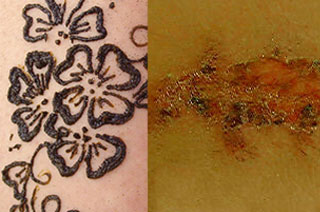
Black henna is prepared by mixing a para-phenylene diamine (PPD) that makes it stay for a longer time and gives a darker shade of henna and is also responsible for quick drying. However, PPD has not been recommended for use of skin and is legally allowed only in hair-dyes, by FDA.
Yet, this doesn’t seem to bother tattoo artists and women – most of whom are not even aware of such a chemicals and its hazards. Unlike henna, which is a dye made out of powdering a the henna plant and is harmless, the PPD can cause blisters and ‘topical corticosteroids’ that can last for a week and leave behind dark marks which stay for upto six-months. The recent reports of allergic reactions from black henna that happened with a 19 year old Kuwaiti girl have raised concerns over women’s health and henna additives. And this is not the first time dermatologists have come across such a case.
So if women think that temporary henna cannot be a something to worry about just because it is temporary, its time that you become wary of chemicals added in henna and their consequences that can also led to permanent scarring. Dermatologists from American Academy of Dermatology warn for women to stay away from PPD and temporary henna tattoos.
